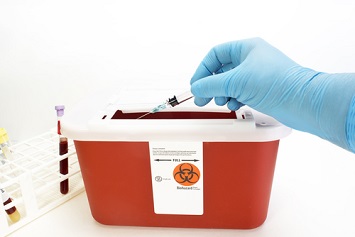If your organization operates a medical facility, or has a large enough campus to warrant having an onsite health clinic, there’s a good chance you need to deal with various types of medical waste. Sharps are of particular concern, as they can pose several different risks. One question that pops up for facility managers whose buildings generate waste in the form of needles or other sharps, relates to how these should be disposed of in the central accumulation area (CAA). Can they stay in their red biohazard bins with a label? Read on to see how regulatory experts at Enviro.BLR.com® answered the question.
We do not know of any regulations that would prohibit moving red biohazard bins containing sharps to a RCRA hazardous waste central accumulation area (CAA) provided the generator of the sharps is in compliance with the OSHA Bloodborne Pathogens standard (29 CFR 1910.1030) and any applicable state regulations addressing medical waste and hazardous waste. The OSHA Bloodborne Pathogens standard requires the following in connection with the management of sharps:
- The area where contaminated sharps are being accumulated (before they are moved to a CAA or elsewhere) is located as close as is feasible to the immediate area where sharps are used or can reasonably anticipated to be found
- Containers of contaminated sharps being moved from the area of use are closed immediately before removal to prevent spillage or overflow of contents during handling, storage, transport, or shipping.
- Before being moved, the containers are placed in a secondary container if leakage is possible
- If a secondary container is required, that container must be closable; constructed to contain all contents and prevent leakage during handling, storage, transport, or shipping; and properly labeled or color-coded.
- Warning labels are affixed to the sharps containers and, if applicable, the secondary container. Labels must include the biohazard symbol and the word “BIOHAZARD” and be fluorescent orange or orange-red with lettering and symbols in a contrasting color. Red containers may be substituted for labels.
Under RCRA, sharps that have not been used to administer hazardous waste pharmaceuticals are considered “solid wastes” which are regulated primarily by states and managed in most under the state’s solid and/or medical waste regulations although sometimes regulation is by the state’s health department. Because sharps could contain bloodborne pathogens or other infectious materials, OSHA’s Bloodborne Pathogens standard requires that disposal of “all regulated waste” (e.g. solid and medical waste) “be in accordance with applicable regulations of the United States, States and Territories, and political subdivisions of States and Territories.”
Medical waste state regulations typically address the collection, packaging, labeling, pre-treatment before disposal, and transport requirements of regulated medical waste, including sharps. Although it is also possible that a state, under either its medical waste or hazardous waste regulations may prohibit the accumulation of nonhazardous sharps in a CAA, we are not familiar with any such prohibitions. Consequently, a state’s hazardous waste and medical waste regulations would need to be reviewed to determine whether there are provisions that address storing red biohazard bins containing sharps.
Note: This question was answered by experts at Enviro.BLR.com.

